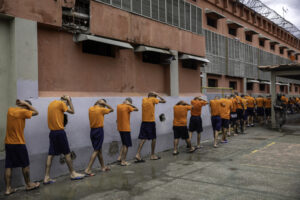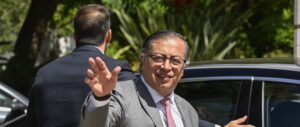For interesting commentary on the Salvadoran gang truce, see the NPR interview with Carlos Dada, the editor of El Faro, a Salvadoran online newspaper (and one of the winners of the 2012 WOLA Human Rights Award), and Alex Sanchez, a Salvadoran-American in Los Angeles who has worked with gang-involved youth in the United States.
On March 10, imprisoned leaders of the two largest street gangs in El Salvador, MS-13 (Mara Salvatrucha) and the 18th Street Gang (Barrio 18), announced a truce, suspending violent conflicts between the two gangs. The gang leaders had held a series of meetings, reportedly mediated by Monsignor Fabio Colindres, the head chaplain of the military and police, and Raúl Mijango, a former mid-level FMLN commander and former advisor to the Minister of Public Security, retired General Munguía Payés, when Munguía was Minister of Defense. Nearly two months later, the leaders announced that they would extend their cease-fire to school zones, as well as bring an end to forced recruitment. Most recently, as part of the truce, the gangs handed over around 80 firearms as a demonstration of good faith. The truce, which has held for nearly 150 days, has led to a dramatic reduction in homicides, which have dropped from an average of nearly twelve a day to approximately five a day.
Many are skeptical about the truce and its sustainability. Gang leaders in prison worked out the truce, asserting that they were weary of violence and eager to see peace on the streets. Some observers are not all convinced by their stated motives. Some argue that the imprisoned gang leadership are using the truce to consolidate their positions and their political power. Some believe that government officials, despite their protestations that they did nothing more than facilitate the meetings between gang members and move leaders to prisons with better conditions as a goodwill gesture, secretly negotiated with the gangs, perhaps offering concessions in return for a lower murder rate. Others worry that even if imprisoned gang leaders are sincere, they will have trouble sustaining the truce because they would not be able to successfully impose it on gang cliques in the street. Some have raised concerns that while there is strong evidence that homicides have declined, there are questions about whether extortions and disappearances have increased over the same period of time.
It’s difficult to judge many of these issues. Gang leaders have been in discussions among themselves for some time, and one can imagine that imprisoned leaders might have come to feel that the violent deaths of young people were needless. It’s harder to imagine that sense of weariness with violence being as strong among the leaders and members of cliques on the street. This situation raises the question of how long the loyalty to imprisoned leaders can be sustained and what kind of incentives have to be offered so that street-level cliques maintain the peace.
The dialogue which led to the truce was, not surprisingly, conducted in secret. What roles Monsignor Colindres and Raúl Mijango played and what discussions they had with government officials and/or gang leaders is unknown. President Funes and the Minister of Public Security continue to deny that the government played any role in the process, though Munguía has publicly asserted that the truce was part of his overall strategy. It’s not clear what role government officials played or whether they made agreements as part of the dialogue which led to the truce.
These are serious concerns that need to be answered if the current truce between the gangs is to evolve into a serious dialogue with government and society.
That said, it is important to recognize that the truce has lasted longer than almost anyone expected, lowered homicide rates dramatically, and saved many lives. Imprisoned leaders have demonstrated both an ability to command the loyalty of gang members on the street and a willingness to reduce violence that is greater than most observers anticipated, and they should be credited for that. Skepticism about motives and legitimate questions about sustainability should not blind us to the real gains that have been made.
Beyond that, the current truce opens a tremendous opportunity: Salvadoran society, the Salvadoran government, the Salvadoran private sector, and international donors should move quickly to use the pause in violence to help install social service and job programs in some of the poorest and most gang-ridden communities, in a way that responds to the real needs of those communities most affected by violence. The Funes administration must take advantage of this moment to work with Salvadoran society in developing a solid, long-term, comprehensive anti-gang strategy that emphasizes violence prevention, reintegration, and rehabilitation. Quick movement, even of small amounts of money, for outreach centers, job training and placement programs, and other activities could send an important and positive message that might help transform the short-term violence reduction that has accompanied the truce into a long-term lowering of crime and violence rates.
You don’t have to trust the truce to see the opportunity it presents.


